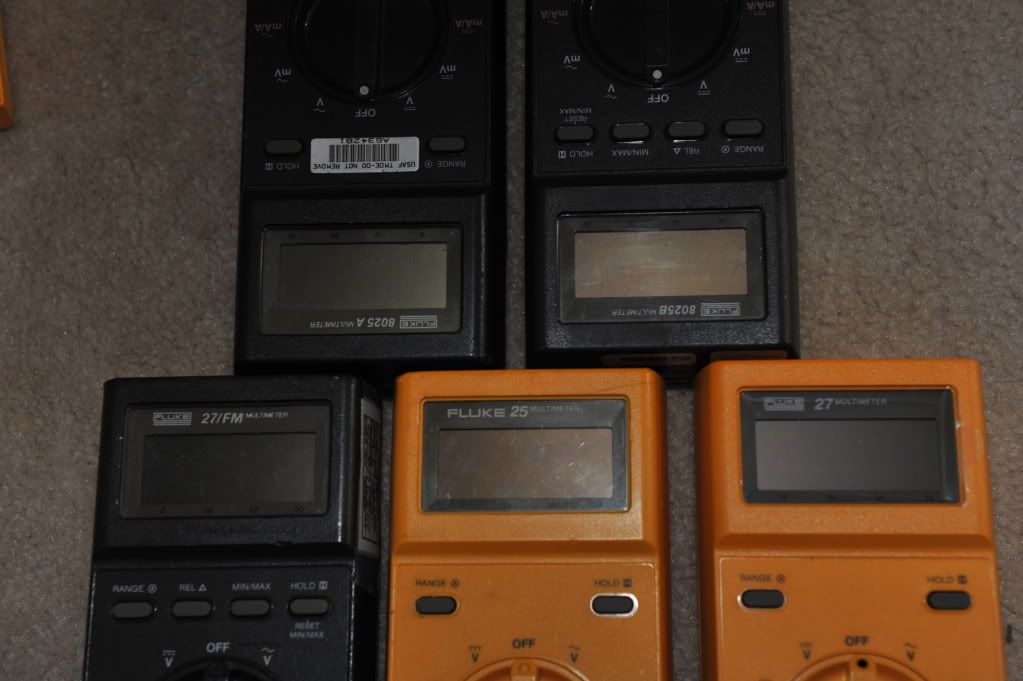Helo Kibi, and welcome!
I have two or three of the 25 model in the yellow case, and several more various versions of this meter. 27, 27/FM, 25 in green case, etc.)
I don't know much about the history, but I'll tell what I do know, and what I can theorize from the many examples I have seen.
The first generation meters:
These were the 8025a and 8025b. They were dark greenish brown, or maybe it is brownish green. These were only made for the US government.
Tbe only difference between the two is that the 8025a is missing the two center buttons. (Max/Min and Rel) Oddly, the internal circuit boards are the same - an 8025B front case and rubber button assy will turn a 25/8025a into a 27/8025b.
The second generation meters:
These were the 25, 27 and the 27/FM. The 25 is just like the 8025a, and the 27 is just like the 8025B. (Only the 27 has the center two buttons - Max/Min and Rel.) All were still in the brownish green case. The 25 and 27 were sold to the civilian market. The 27/FM was only sold to the military. I'm not sure of the exact timing, which came first, if there was any overlap with the 8025's, etc.
The military model of the 27, the 27/FM is the only meter of this type with the "True RMS" feature. There is actually an extra IC in the meter labeled "Fluke RMS."
The third generation meters:
These had yellow cases instead of the green. Models were still the 25 and 27. I'm not sure if there was any overlap of any of the green models with the yellow. These yellow meters were sold to civilians for use in mines, and, as you note, were rated by the MHRA. I've never seen a green one with that rating, but, all of these are the same, with the exception of the True RMS feature of the 27/FM.
There is "sort of" a 27/FM yellow meter, but "27/FM" appears only on a sticker on the back. These latest government meters of this type look just like the civilian, yellow, 27 meters on the front. Like all civilian 25s and 27s, these are NOT true rms. (very confusing - to keep it straight, I don't call these 27/FMs, I only call the true RMS version a 27/FM. That is, I go by the mainboard, not the sticker on the back)
Also, sometime in the "third generation," the Fluke logo was changed from the Fluke enclosed by the white rectangle with lines below to just the word FLUKE in a larger font.
These yellow meters were sold until a year or so ago, when the 27-II and 28-II were introduced to replace them. The 27-II is not true RMS, the 28-II is.
Dave has a great review of the 28-II in which he took one canyoning. He had to work pretty hard to damage it, and it was repaired easily. (broken LCD, broken inductor) Looks like the new series is a winner.
The green meters (8025a, 8025b, 27/FM) were produced in great numbers for the US government, and are now showing up as surplus. The new type 27s (with only the sticker on the back calling them 27/FM) are also now being sold through surplus outlets.
While not as rugged as the 27-II and 28-II, these are rugged meters and are very reliable. I have about 40-50 of these - and only three that are inoperative - one due to water submersion (cracked case. an intact case is waterproof, provided the seals are in good condition and properly greased, as Dave explained in one of his blogs.) (another two or three were fixed with parts from these three)
Kiriakos, these have about 5 MOVs in the input, and I've seen meters with all 5 blown. I changed them, and the meter worked and the cal was in spec. Do you still have yours? Maybe it's repairable. I'll gladly send you parts and/or offer any help I can.
This is my favorite meter, probably because it's possible to buy them cheaply, they have millivolt and micro-ampere ranges in both AC and DC, and remain accurate despite a lot of abuse. Some E-bay sellers sell these for 200-400 dollars, but I've seen new condition meters go for as low as 50, and good working models can be had for 20. (all US dollars)
I use these for my "knock around, general purpose" use. I have 87s that I use for electronic work, and the "big gun" 189-II (same as a 287) that I drag out on occasion. Before i got a deal on the 189-II, I bought a 189, and got a "fixer upper" 187 as well. As Dave pointed out, the 287s are big and heavy. The 189 and 187, although larger than the 87, is a bit smaller, and, more importantly, can be used without all of the button pushing that is involved with the 280 series.
Some pictures of meters I had handy:


Note the meter at the lower right - it's a 27 meter with a 25 front case and buttons. I found a new 25 case on E-bay and used it to fix a 27 with a very smashed front case. I should have changed the bezel to a 25, but I didn't have one at the time.
EDITED - hopefully to improve clarity. No fact changes were made, only re-stating and adding facts.